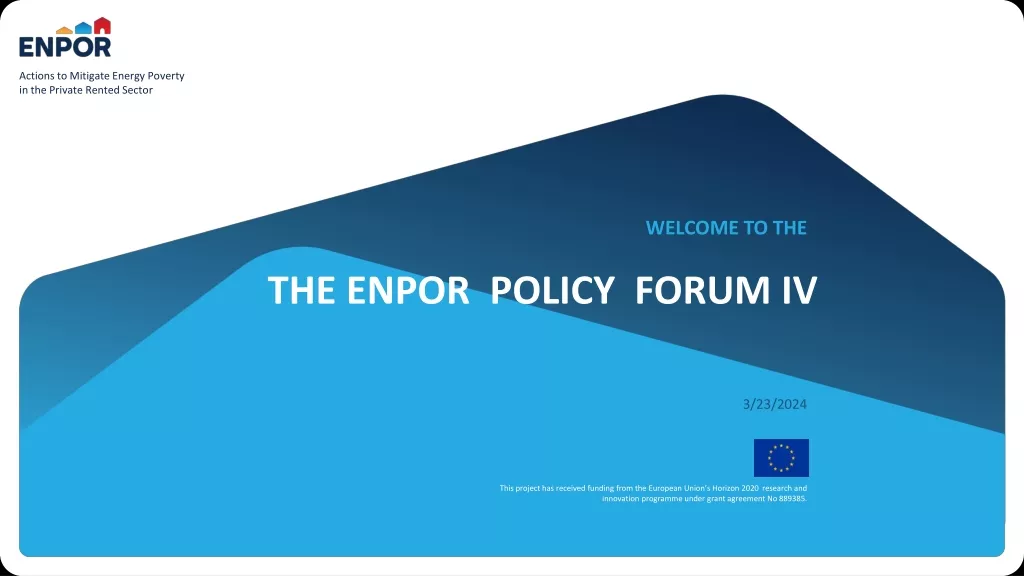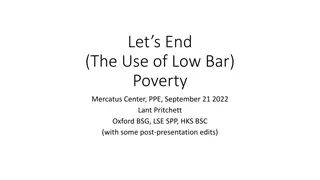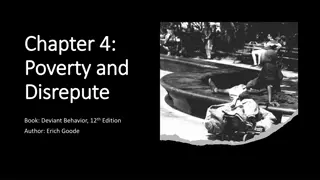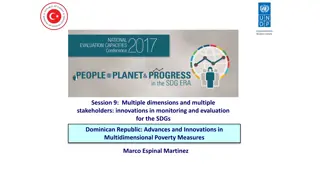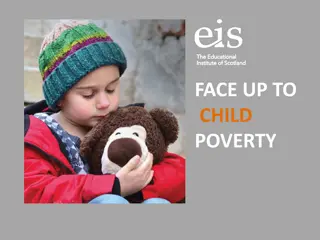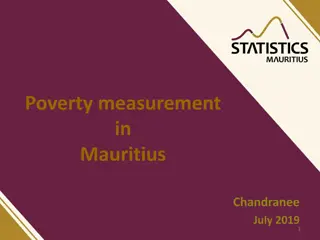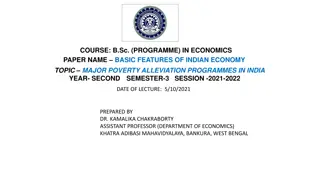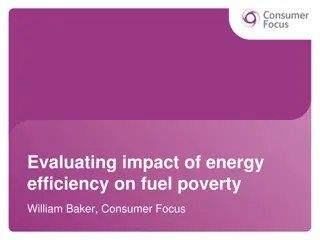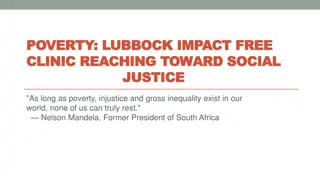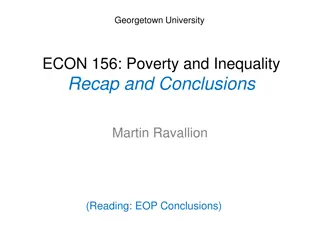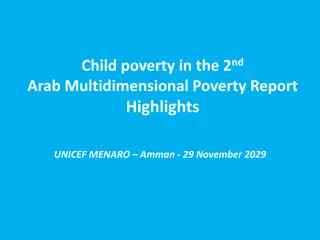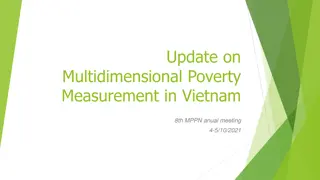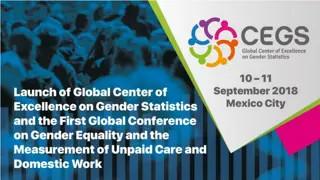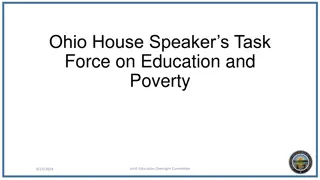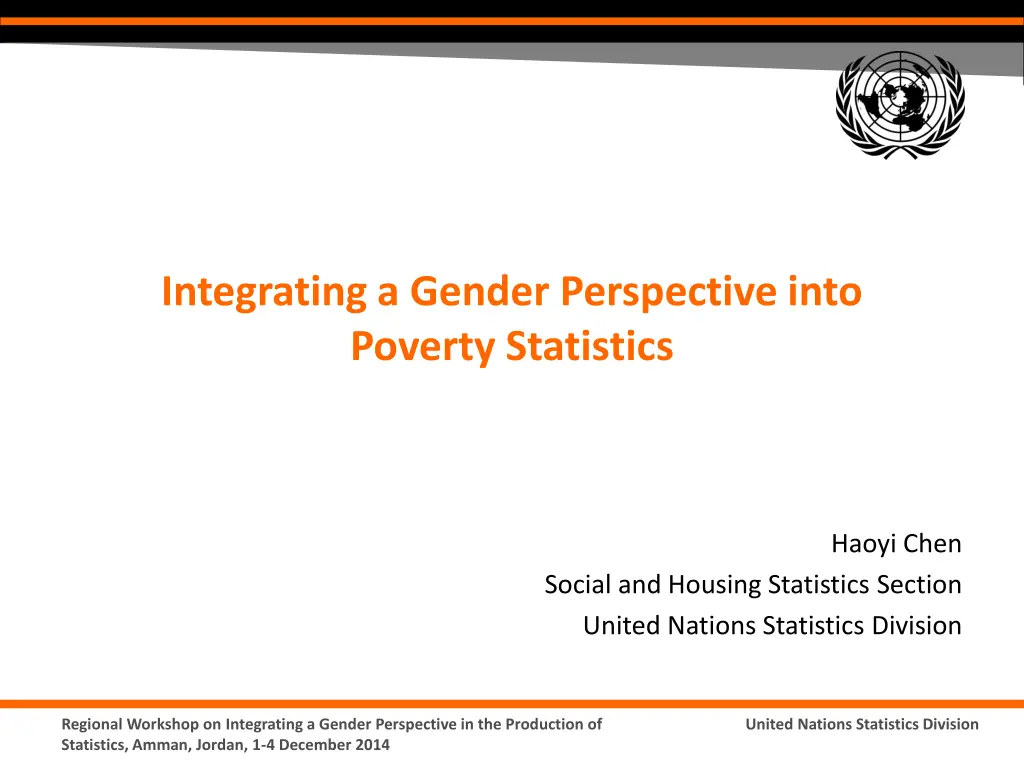
Integrating Gender Perspective in Poverty Statistics
Learn about the importance of integrating a gender perspective into poverty statistics through measuring poverty at household and individual levels, economic autonomy of women, and more. Explore examples and insights from the Regional Workshop on Integrating a Gender Perspective in the Production of Statistics held in Amman in 2014 by the United Nations Statistics Division.
Download Presentation

Please find below an Image/Link to download the presentation.
The content on the website is provided AS IS for your information and personal use only. It may not be sold, licensed, or shared on other websites without obtaining consent from the author. If you encounter any issues during the download, it is possible that the publisher has removed the file from their server.
You are allowed to download the files provided on this website for personal or commercial use, subject to the condition that they are used lawfully. All files are the property of their respective owners.
The content on the website is provided AS IS for your information and personal use only. It may not be sold, licensed, or shared on other websites without obtaining consent from the author.
E N D
Presentation Transcript
Integrating a Gender Perspective into Poverty Statistics Haoyi Chen Social and Housing Statistics Section United Nations Statistics Division Regional Workshop on Integrating a Gender Perspective in the Production of Statistics, Amman, Jordan, 1-4 December 2014 United Nations Statistics Division
Regional Workshop on Integrating a Gender Perspective in the Production of Statistics, Amman, Jordan, 1-4 December 2014 United Nations Statistics Division
Measuring poverty from a gender perspective Household level poverty Numbers of women and men living in poor households Female vs male headed households Individual level poverty Intrahousehold allocation of resources Economic autonomy of women Regional Workshop on Integrating a Gender Perspective in the Production of Statistics, Amman, Jordan, 1-4 December 2014 United Nations Statistics Division
Gender and Household level income/consumption poverty Regional Workshop on Integrating a Gender Perspective in the Production of Statistics, Amman, Jordan, 1-4 December 2014 United Nations Statistics Division
Women and men living in poor households Household 1 $5/day per person Not poor Poverty line $1.25/day per person Household 2 $1/day per person Poor Calculation: based on household income or expenditure Regional Workshop on Integrating a Gender Perspective in the Production of Statistics, Amman, Jordan, 1-4 December 2014 United Nations Statistics Division
Women and men living in poor households Women and men living in poor households Example Example: Poverty rates by sex of the household members, selected African countries,1999-2008 (latest available) (Source: United Nations, 2010) Regional Workshop on Integrating a Gender Perspective in the Production of Statistics, Amman, Jordan, 1-4 December 2014 United Nations Statistics Division
Women and men living in poor Women and men living in poor households households significant differences between female and male poverty rates for European countries (countries with higher proportions of one- person households, especially of older persons) Example Example: Poverty rates by sex of the household members, European countries, 2007-2008 (latest available) (Source: United Nations, 2010) Regional Workshop on Integrating a Gender Perspective in the Production of Statistics, Amman, Jordan, 1-4 December 2014 United Nations Statistics Division
Women and men living in poor households: Women and men living in poor households: A poor measure of gender gap in poverty?! A poor measure of gender gap in poverty?! Intrahousehold inequality not taken into account - women who are poor but live in non-poor households are not counted among the estimated poor Poverty rate comparison across countries influenced by Household living arrangement: higher share of women with less income in one household vs 1-person families Ageing: more women than men in older ages It is just the distribution of population by sex in poor households! Regional Workshop on Integrating a Gender Perspective in the Production of Statistics, Amman, Jordan, 1-4 December 2014 United Nations Statistics Division
Women and men living in poor households Women and men living in poor households Can be useful to point out the vulnerability of older women in certain contexts (especially in countries with high proportion of older persons living alone) Example Example: Share of women in population and total poor, below and above 65 years, European countries, 2007-2008 Regional Workshop on Integrating a Gender Perspective in the Production of Statistics, Amman, Jordan, 1-4 December 2014 United Nations Statistics Division (Source: United Nations, 2010)
Poverty rate: female- and male-headed households Variation by type of households Poverty rate by sex of the head of the household, Latin America and the Caribbean, 1999-2008 (latest available) Regional Workshop on Integrating a Gender Perspective in the Production of Statistics, Amman, Jordan, 1-4 December 2014 United Nations Statistics Division (Source: United Nations, 2010)
Poverty rate: female- and male-headed households Variation by definition of household head Example: Poverty rate for three sets of female Poverty rate for three sets of female- -headed households, Panama, 1997 LSMS headed households, Panama, 1997 LSMS Self-declared female-headed households: 29% poverty rate Only 40-60% overlapping between categories Households headed by working female : 23% poverty rate (more than half of total household labour hours worked by a single female member) Potential female-headed households: 21% poverty rate (no working-age male present) Regional Workshop on Integrating a Gender Perspective in the Production of Statistics, Amman, Jordan, 1-4 December 2014 United Nations Statistics Division (Source: Fuwa, 2000)
Female-male difference in poverty rate for one- person households Regional Workshop on Integrating a Gender Perspective in the Production of Statistics, Amman, Jordan, 1-4 December 2014 United Nations Statistics Division (Source: United Nations, 2010)
Poverty rate: female- vs male-headed households The unresolved issue: gender-based inequality within the household. Within the same household: Women may have a subordinated status relative to men Women may have less decision power on intrahousehold allocation of resources Fewer resources may be allocated to women and girls Difficult to measure intrahousehold inequality using consumption as an indicator of individual welfare (food/housing/water supply/sanitation) Female-headed households and male headed households are heterogeneous categories: Different demographic composition Different economic composition The head of household may not be identified by the same criteria Use of different poverty line may have an impact on the female and male comparison Regional Workshop on Integrating a Gender Perspective in the Production of Statistics, Amman, Jordan, 1-4 December 2014 United Nations Statistics Division
Poverty rate: Female- and male-headed households key points Disaggregate the types of female- and male-headed households, as relevant for your country, as much as possible, by taking into account demographic and/or economic characteristics of the household members Use clear criteria in identifying the head of household Specification of criteria for identifying the head of household in the field in the interviewers manual and during training (make sure female heads of household are not underreported, especially when adult male members are part of the household) Use for analysis heads of household identified, at the time of the analysis, based on demographic and/or economic characteristics Avoid using self-identified heads based on no common criteria Try analysis based on different poverty lines Regional Workshop on Integrating a Gender Perspective in the Production of Statistics, Amman, Jordan, 1-4 December 2014 United Nations Statistics Division
Measuring poverty based on individual Measuring poverty based on individual- -level data: a requirement for gender statistics requirement for gender statistics level data: a Regional Workshop on Integrating a Gender Perspective in the Production of Statistics, Amman, Jordan, 1-4 December 2014 United Nations Statistics Division
A. Use of non A. Use of non- -consumption indicators of poverty consumption indicators of poverty Non-consumption indicators more successful in illustrating gender inequality in the allocation of resources within the household Measured at individual level Correspond to a shift in thinking poverty: from poverty as economic resources to avoid deprivation to poverty as actual level of deprivation, not only in terms of food and clothing, but also in areas such as education and health Examples of potential dimensions for individual-level measures of poverty and intrahousehold inequality: Education Health and nutrition Time use Access to food and clothing Asset ownership Participation in intrahousehold decision- making Social participation No consensus of what dimensions to include + need for international standards on individual-level measures of gender-related intrahousehold poverty and inequality Regional Workshop on Integrating a Gender Perspective in the Production of Statistics, Amman, Jordan, 1-4 December 2014 United Nations Statistics Division
B. Access to income, property ownership and credit B. Access to income, property ownership and credit Access to income Gender division of labour: women spend more of their time on unpaid domestic tasks; on the labour market, women are more often than men in vulnerable employment with low or no cash returns As a result, compared to men, women s income tends to be smaller, less steady and more often paid in-kind Ownership of housing, land, livestock or other property Gender inequality with regard to inheritance rights, rights to acquire and own land, and rights to own property other than land; women may not be able to obtain property that is rightfully theirs due to lack of education, information and knowledge of entitlements. As a result, women tend to have less access to property than men Access to credit Women more likely to lack income and property ownership to be used as collateral for credit; women s business may be more often in informal or low-growth sectors with less opportunities for loans As a result, women s chances to obtain formal credit are smaller than men s. Regional Workshop on Integrating a Gender Perspective in the Production of Statistics, Amman, Jordan, 1-4 December 2014 United Nations Statistics Division
Example: access to income (Source: United Nations, 2010) Regional Workshop on Integrating a Gender Perspective in the Production of Statistics, Amman, Jordan, 1-4 December 2014 United Nations Statistics Division
Property ownership by sex The EDGE project: developing guidelines on measuring individual-level asset ownership (Source: United Nations, 2010) Regional Workshop on Integrating a Gender Perspective in the Production of Statistics, Amman, Jordan, 1-4 December 2014 United Nations Statistics Division
Access to income, property ownership and credit Access to income, property ownership and credit From gender issues to gender statistics From gender issues to gender statistics Policy-relevant questions on gender Data needed Sources of data Employment by type of income and sex. Household surveys such as living standard surveys, LFS, DHS, or MICS Do women earn cash income as often and as much as men? Value of individual income by sex Living standard surveys such as LSMS or EU-SILC (European Union Statistics on Income and Living Conditions) Individual ownership of land by sex Household surveys such as living standard surveys; agricultural censuses or surveys Do women own land as often and as much as men? Do women appear as often as men on housing property titles? Distribution of land size by sex of the owner Multi-purpose household surveys; administrative sources Distribution of housing property titles by sex of the owner Do women apply for and obtain credit as often as men? Are some types of credit and some sources of credit more often associated with women than men? Applicants for credit by sex, purpose of credit, source of credit and approval response. Multi-purpose household surveys, including LSMS surveys Regional Workshop on Integrating a Gender Perspective in the Production of Statistics, Amman, Jordan, 1-4 December 2014 United Nations Statistics Division
Access to income, property ownership and credit Access to income, property ownership and credit Gender Gender- -related measurement issues related measurement issues Data on individual income and its share in total household income difficult to measure in some countries and may be more severely underestimated for women Data on ownership and access to credit most often collected only at household level or agricultural holding level, without the possibility of identifying joint ownership. When data on ownership of agricultural resources and decision-makers are not collected at more disaggregated level (individual level and subholding level - such as plots of land and type of livestock), the status of women and men may be misrepresented. Regional Workshop on Integrating a Gender Perspective in the Production of Statistics, Amman, Jordan, 1-4 December 2014 United Nations Statistics Division
The gendered experience of poverty The gendered experience of poverty Regional Workshop on Integrating a Gender Perspective in the Production of Statistics, Amman, Jordan, 1-4 December 2014 United Nations Statistics Division
Example: Primary school net attendance rate for girls and boys by wealth quintiles, Yemen, 2006 Per cent 100 90 Boys 80 Girls 70 60 50 40 30 20 10 0 Poorest 20% Q2 Q3 Q4 Richest 20% Source: Ministry of Health and Population and UNICEF, 2008. Yemen Multiple Indicator Cluster Survey 2006, Final Report Regional Workshop on Integrating a Gender Perspective in the Production of Statistics, Amman, Jordan, 1-4 December 2014 United Nations Statistics Division
Example: Women age 15-49 who have experienced physical violence since age 15 by wealth quintile, India, 2005-06 Per cent 50 40 30 20 Source: Ministry of Health and Family Welfare Government of India, 2007. National Health Family Survey 2005-06 10 0 Poorest quintile Second quintile Middle quintile Fourth quintile Wealthiest quintile Regional Workshop on Integrating a Gender Perspective in the Production of Statistics, Amman, Jordan, 1-4 December 2014 United Nations Statistics Division
Example Example: Married women aged 15-49 not participating in the decision of how own earned money is spent, for poorest and wealthiest quintiles, 2003-08 (latest available) Source: United Nations, 2010 Regional Workshop on Integrating a Gender Perspective in the Production of Statistics, Amman, Jordan, 1-4 December 2014 United Nations Statistics Division
Frequent problem in tabulation of data: sex just one of many variables listed in a two-way table (see example) Make sure data are tabulated disaggregated by sex, poverty status/wealth category AND the characteristic of interest at the same time. Regional Workshop on Integrating a Gender Perspective in the Production of Statistics, Amman, Jordan, 1-4 December 2014 United Nations Statistics Division
Three key points in improving the availability and quality of gender statistics in the area of poverty Use detailed types of female- and male-headed households to obtain more relevant household-level statistics on gender and poverty Use a broader concept of poverty to highlight issues of gender-based intrahousehold inequality and economic dependency of women on men Use disaggregated data by poverty or wealth status to highlight the gendered experience of poverty (poverty affecting women and men in different ways) Regional Workshop on Integrating a Gender Perspective in the Production of Statistics, Amman, Jordan, 1-4 December 2014 United Nations Statistics Division
Visit us at: http://unstats.un.org/unsd/gender/default.html Regional Workshop on Integrating a Gender Perspective in the Production of Statistics, Amman, Jordan, 1-4 December 2014 United Nations Statistics Division

